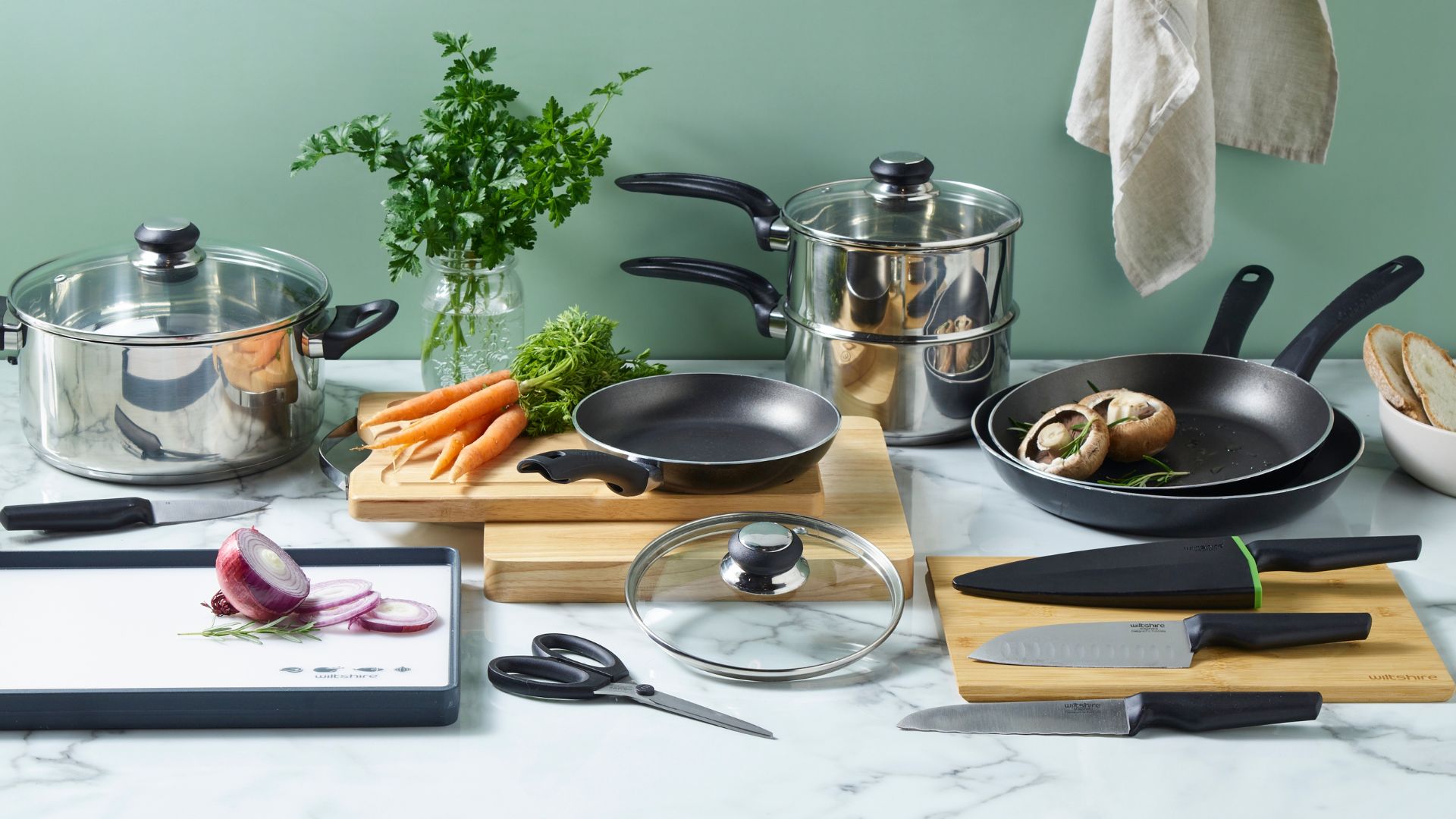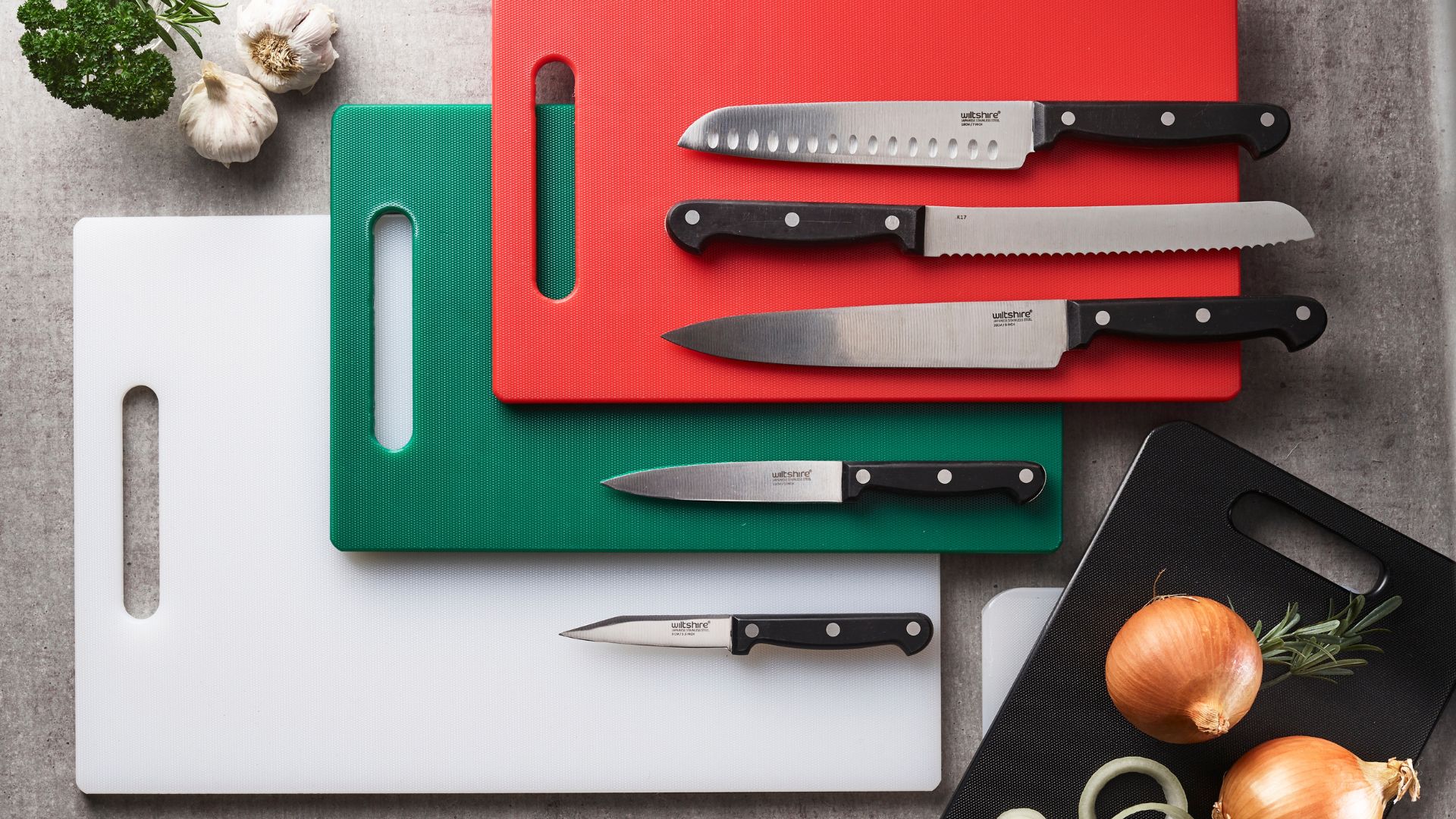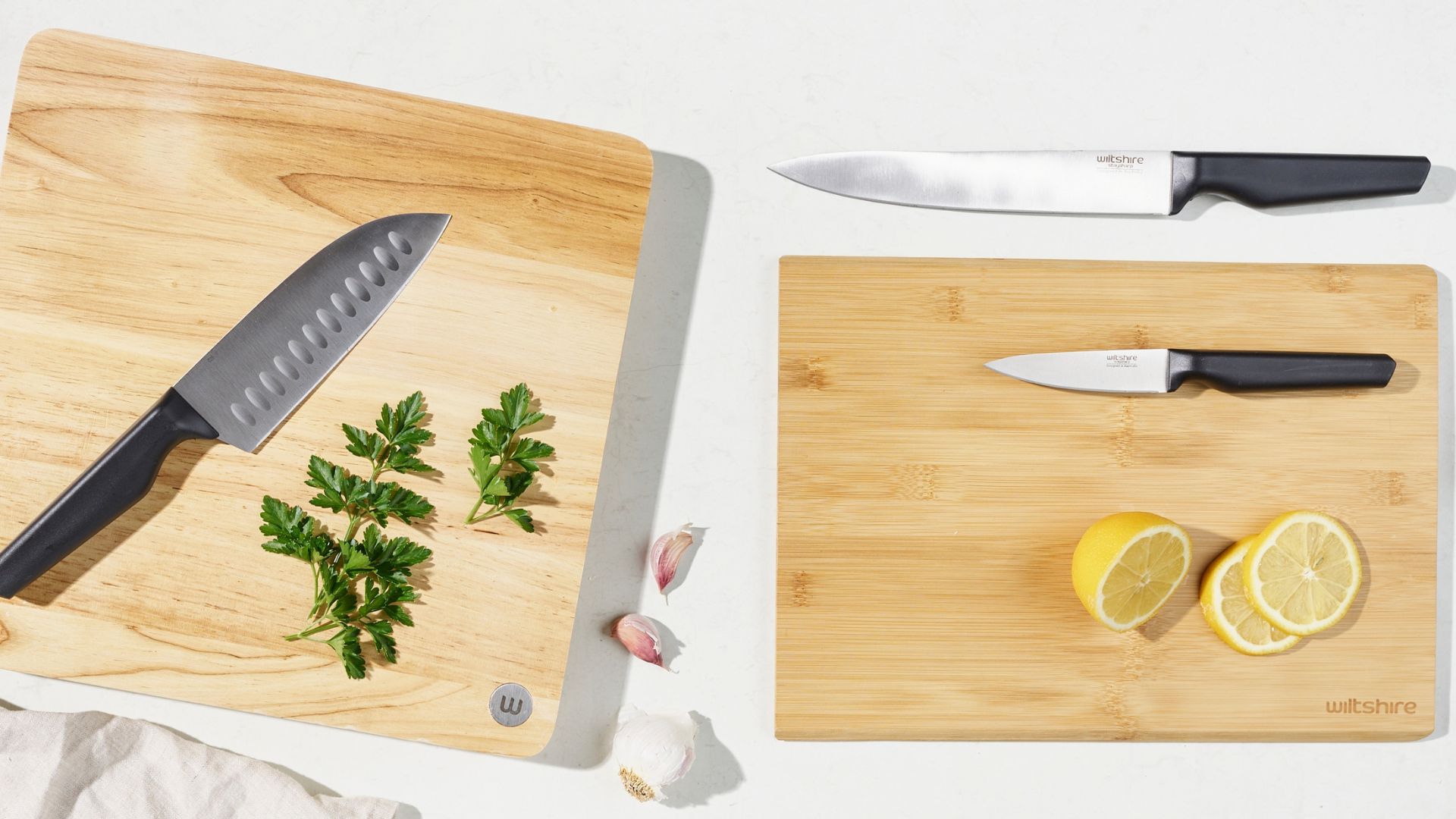 | ||
| Your browser is not supported. | ||
|
Please browse our site using any of the following options:
| ||
How To Clean A Chopping Board

Chopping boards are a vital part of food preparation, ensuring you can carve, slice and dice your food safely without damaging your benchtop or kitchen knives. At Spotlight we have a great range of chopping and cutting boards for you to choose from, and how you care for them will depend on what kind of material your cutting board is made from.
In this guide we'll detail the most common (and some of the rarer) types of chopping boards you can find, how to clean a chopping board properly depending on its material, and other care tips that will extend the life of your board and keep it looking pristine.
Quick Links
- What Kinds Of Chopping Boards Are There?
- How To Care For A Plastic Chopping Board
- How To Care For A Wooden Chopping Board
- How To Care For A Glass Chopping Board
What Kinds Of Chopping Boards Are There?
Chopping boards are either square or rectangular and can be made in a variety of materials including:
- Wood: The most popular material used for chopping boards is wood, usually acacia, cherry, walnut and maple. You want a wood that is moderately hard - too hard and it will blunt your knives, too soft and it might chip or break. Wood that is not too porous is also a plus, as it will help prevent the board from absorbing liquids from your food.
- Plastic: These boards come in a variety of colours and are easy to clean, making them the favourite choice for busy families. They are light and easy to work with, although they cannot be repaired once they start to wear.
- Glass: Modern and sleek, glass chopping boards are the easiest to clean as food and liquids will slide off their non-porous surface. They can break if dropped and will blunt your knives, so they need to be used carefully!
- Marble: Beautiful and elegant, marble chopping boards almost look too good to use. Like glass boards, they can blunt your knives and they require a fair bit of care and upkeep to maintain their look. We recommend using your marble boards for displaying and serving food, rather than for cutting.
When deciding how to clean a chopping board, the main thing you need to consider is what it is made of. A wooden chopping board cleans very differently from a glass one, but don't worry - we'll detail how to clean a plastic chopping board, a wooden board and a glass board in the following paragraphs.
Chopping board colours
Many commercial kitchens use colour-coded chopping boards for cutting different kinds of food. This prevents cross-contamination and is important to help prevent people with allergies from getting sick. If you live in a household with allergies, it may be beneficial for you to colour-code your chopping boards too! Because of their synthetic material, plastic boards are usually used when coloured chopping boards are needed because they are easy to colour and colours show up brightly, as opposed to wood or bamboo. While you can technically choose whatever colour you want for your boards, here are the standard chopping board colours most kitchens will follow:
- Red for raw meat: All kinds of raw meat, including beef, pork, lamb and chicken, should be prepared on a red board. While allergens aren't really a problem with these proteins, they will help prevent the spread of bacteria from raw meat to other chopping boards. Red chopping boards should always be washed thoroughly after use.
- Yellow for cooked meat: While there isn't as much danger of bacterial transfer from cooked meat as there is from raw meat, you should still slice cooked meats on their own chopping board. These should also be washed using hot, soapy water.
- Blue for seafood: Seafood can be a dangerous allergen, so it definitely needs its own chopping board colours! Seafood includes fish, mussels, oysters, prawns, lobster, squid and crab. Clean your blue board using hot water and soap to remove any bacteria and also prevent any fishy smells from sticking around.
- Brown for vegetables: Root vegetables can be dirty, hence the brown chopping board. These include beetroot, onions, ginger, turmeric, celery, parsnip, carrot and potato. Wash your brown board thoroughly to remove any dirt and juices.
- Green for fruits and salad: Use a green board for washed salads, fruits and herbs. These include berries, apples, melons, lettuce, capsicum, cucumber, tomato, mint, coriander and parsley. Wash using warm water and soap to remove any juices and seeds.
- White for bread and dairy: Gluten allergies from bread and lactose allergies from dairy means your white board should also be washed properly, even though it's tempting to just wipe off the crumbs and store the board again. Foods for this board include loaves of bread, cakes, rolls and both soft and hard cheeses.
- Purple for other allergens: If your family member has any other allergens that you'd like to avoid (like nuts, soy or eggs), then use a purple board to prepare this food for your other family members and always wash it using hot water and soap.
Many cutting board packs will contain all the chopping board colours in one purchase - some even have labels detailing what board is used for which food. Make sure to replace your coloured chopping boards once they start to show signs of wear and tear and label your chopping board colours if needed.
How To Care For A Plastic Chopping Board
Plastic chopping boards are light and thin, making them easy to use and store away. Plastic chopping boards come in a range of colours and are less likely to slip than other chopping boards, especially when made of a rubbery plastic like polypropylene.
How to clean a plastic chopping board
One of the great things about plastic boards is, because they are synthetic and non-porous, they can be popped in the dishwasher! Some plastic chopping boards can warp under high heat, so remove them before the drying cycle in your dishwasher to prevent them from becoming misshapen and unstable.
You can also hand wash your plastic chopping board using hot water and dish soap. This allows you to scrub off any potential stains and clingy scraps, which your dishwasher may miss. If your white plastic board needs a thorough scrub, you can create a mixture of bleach and water to sponge clean it before rinsing it with water and standing it up to dry.
If your plastic chopping board has a stain you just can't get rid of, create a paste using equal parts baking soda, salt and water. Scrub the paste into the stain, leave for a few minutes and then rinse off and clean as normal.
When to replace your plastic chopping board
Once your plastic chopping board is showing multiple cuts and grooves, it's time to replace it. Unfortunately, plastic chopping boards cannot be mended and bacteria can live and grow in these cuts no matter how ferociously you try to clean them. Luckily they are also the most affordable type of chopping board, so it's not hard to find another plastic board you'll love to use.

How To Care For A Wooden Chopping Board
Wooden chopping boards are a stylish and durable choice as a chopping board, although they require a bit of upkeep to maintain their condition and good looks. You can choose from a few different kinds of wood, but all will need to be cared for the same way to prevent them from drying out and cracking.
How to clean a wooden chopping board
Deciding how to clean a wooden chopping board can go a long way in determining how long your wooden cutting board will last. The key to cleaning a wooden chopping hoard is to always hand wash them in your sink. Long exposure to high levels of heat (like in your dishwasher) can cause your wooden chopping board to expand, crack and retain the water, not only forcing it out of shape but also proving a breeding ground for bacteria deep in the cracks of the board.
Scrape any stubborn bits of food off your wooden chopping board with a strong spatula or scraper, then use warm water and mild dish soap to clean it in the sink - avoid soaps with harsh chemicals like ammonia in them. Once it's clean, either hand dry the board with a tea towel or leave it standing up to dry, preferably on a rack. If it standing on a solid surface, make sure water doesn't pool at the bottom of the board, as sitting in this water for too long can encourage mould to grow in small speckles along the bottom of your wooden chopping board.
How to oil a chopping board
Like seasoning a cast iron pan, learning how to oil a chopping board is vital to keeping it in good condition and ensuring any food you make on it is safe to eat. The smooth and slick surface that makes wooden chopping boards so nice to use is due to a coat of food-safe oil. This coat can run dry over time, and once your wooden board has become dry, lightened in colour and absorbs water instead of repelling it, then it's time to add a new coat of oil.
Here are our favourite oils you can use to oil a wooden chopping board:
- Mineral oil mixed with beeswax: Mineral oil is made from paraffin, a by-product of petroleum that is clean, odourless and flavourless. Make sure the mineral oil you choose for oiling a board is food grade, as you can find mineral oil that is used to lubricate machine parts that you definitely don't want getting into your food!
On its own mineral oil will do a decent job of lubricating your wooden cutting board, but we recommend blending it with beeswax for added shine and protection, or at least applying a layer of beeswax after your layer of mineral oil has dried.
- Fractionated coconut oil: You can't just use the regular coconut oil you find at the grocery store, as the fats in coconut oil will go rancid if used to oil your board. Look for fractionated coconut oil (which has had the parts that turn rancid removed) to give your board a soft and smooth protective coat of oil.
- 100% pure Tung oil: Loved in woodworking for its long-lasting protection, Tung oil used for oiling a wooden chopping board must be 100% pure. If the bottle doesn't say either of these things on it, don't use it! The wrong Tung oil is toxic to humans, so you'll want the pure stuff. Please keep in mind Tung oil is made from a tree that bears nuts, so people allergic to nuts should avoid this oil altogether.
- Avoid oils used for cooking like olive, sunflower or vegetable oils, as these will turn rancid and give your board a nasty smell and taste, which will then be passed on to any food you chop on it.
If you're wondering how to seal a chopping board with oil, there are only a few steps you need to take once you've chosen which kind of oil you will be using. Once your wooden cutting board is clean and dry, add a few dollops of oil to your board and use a soft microfibre cloth to work the oil into the grain. Wipe away any excess and let the board dry overnight before using. You can use these same steps for how to seal a chopping board for other wooden utensils like stirring spoons and flat wooden spatulas.
When to replace your wooden chopping board
If your wooden chopping board has started to split or has warped, it may be time to replace it. Small chips and cuts can be sanded away, but any greater repairs should be done by a professional carpenter to ensure all materials used to repair the board are food-safe and water-resistant.
Bamboo chopping boards
While they may look and feel similar to a wooden chopping board, bamboo is actually a type of grass and chopping boards made of it need to be handled a little differently. Bamboo is more porous and denser than most woods used for cutting boards, meaning it is more likely to absorb water and also more likely to blunt your knives. It can still last you a long time if oiled and hand-washed like you would a wooden chopping board, and it is a less-expensive option as well.
How To Care For A Glass Chopping Board
Modern and stylish, a glass chopping board is as much a statement piece as a food preparation tool in the kitchen. Glass chopping boards are smooth and easy to clean, as most food and liquids will slide right off the surface of the board. They are very hard so your knives are easy to dull on them, plus they can break if dropped or even if they are cut into too heavily.
How to wash a glass cutting board
Glass cutting boards are dishwasher friendly, but they are so easy to clean by hand that you almost don't need to bother! Hot water and soap are enough to clean a glass cutting board, and you can pour boiling water over it at the end for a clear shine and to remove any suds. Make sure the board is still warm while you do this, as pouring boiling water over a cold glass board (or putting a very hot glass board in the freezer) can cause it to suddenly break! Dry in a rack or by hand to prevent water droplets from staining the board's surface.
When to replace a glass cutting board
You'll know when your glass cutting board needs replacing, as it will be when it cracks or shatters into pieces! If your glass cutting board has a small chip you should still replace it, as sudden changes in temperature may cause the chip to turn into a large crack.

Discover Quality Chopping Boards At Spotlight
Choose your next chopping board from the collection of chopping boards at Spotlight! Shop for chopping and cutting boards online, safely pay and we'll deliver them straight to your front door. You can also visit your nearest Spotlight store to choose your cutting boards in person.
For more ideas and inspiration for the kitchen, make sure to read our blogs on pantry organisation, how to clean a kettle and ceramic dinnerware explained. And if you need some more information on kitchen supplies and how to care for them, read our buying guides on kitchen tools and utensils, choosing a kitchen knife and how to care for your kitchen knives.




